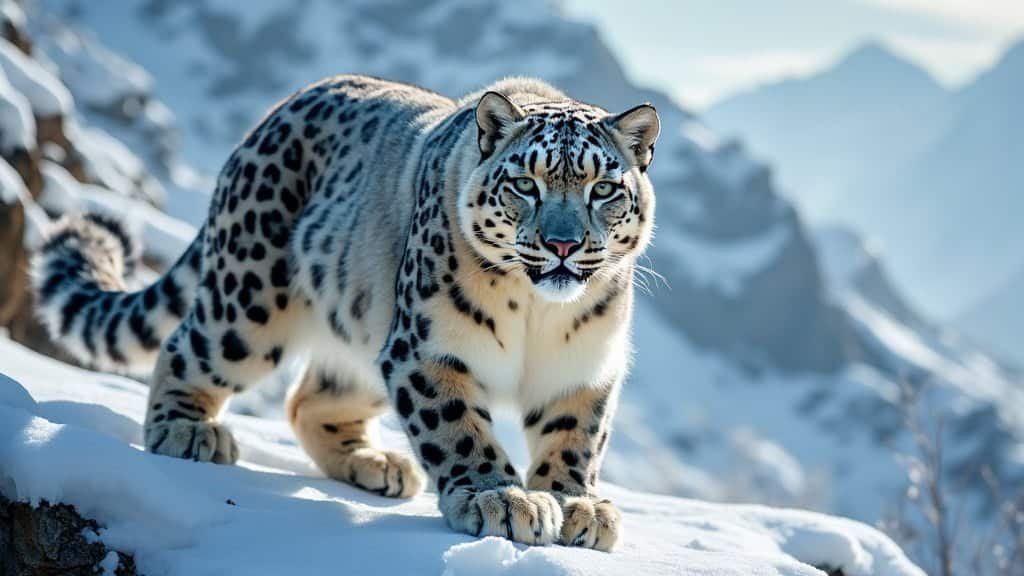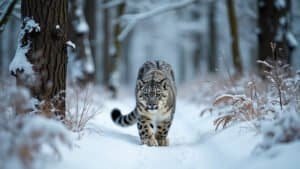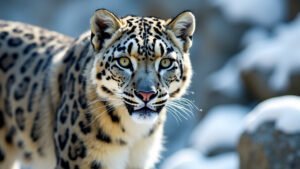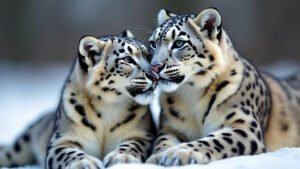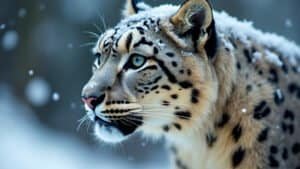Introduction
Snow leopards are remarkable creatures known for their ability to survive in some of the harshest environments on Earth. Their genetic makeup plays a crucial role in enabling them to withstand the extreme cold of high-altitude regions
In this article, we will explore how specific genes contribute to snow leopards’ cold tolerance. We will delve into the genetic factors that enhance their fur’s insulation, their metabolic adaptations, and the specialized features of their paws and tail that help them survive in subzero temperatures
Additionally, we will examine the unique genetic traits that set snow leopards apart from other big cats
What Genes Help Snow Leopards Adapt to Cold?
Snow leopards have evolved several genetic adaptations that enable them to thrive in cold, mountainous regions. These genetic modifications are crucial for their survival, as they live in environments where temperatures can drop well below freezing
Understanding the specific genes involved in these adaptations provides insight into how these big cats have developed their extraordinary ability to tolerate extreme cold
The Role of Genetic Mutations
One of the key factors in the snow leopard’s ability to survive cold climates is the presence of specific genetic mutations. Research has identified several genes that are associated with the regulation of body temperature, metabolism, and fur characteristics
For instance, mutations in the EPAS1 gene, also known as the “super athlete” gene, are linked to high-altitude adaptation. This gene plays a crucial role in how the body responds to low oxygen levels, which is common in the high-altitude regions snow leopards inhabit
The EPAS1 gene helps regulate the production of red blood cells, enhancing the oxygen-carrying capacity of the blood, which is vital in cold, thin air
Another important gene is UCP1 (Uncoupling Protein 1), which is involved in thermogenesis, a process that generates heat in the body. UCP1 is particularly active in brown adipose tissue, a type of fat that produces heat, helping snow leopards maintain their body temperature in freezing conditions
This gene is crucial for non-shivering thermogenesis, a method of heat production that does not rely on muscle activity, making it particularly efficient in conserving energy while generating warmth
Adaptations in Fur Density and Structure
The genetic basis for the dense, thick fur of snow leopards also lies in specific gene expressions that regulate hair growth and structure. Genes such as FGF5 (Fibroblast Growth Factor 5) are known to influence hair length and density
Mutations in FGF5 are associated with longer hair, which provides better insulation against the cold. This gene’s expression is higher in snow leopards than in other big cats, contributing to their exceptionally thick fur, which is one of their most distinctive adaptations to cold environments
Moreover, the KRT (Keratin) gene family, responsible for the structural proteins in hair, is highly expressed in snow leopards. Keratin is a key component of hair and nails, and its abundance in snow leopard fur enhances the durability and insulating properties of their coat
This genetic trait ensures that their fur remains effective even in the most extreme weather conditions, protecting them from wind and snow
Genetic Influence on Metabolic Rate
In addition to genes that affect fur and thermogenesis, snow leopards possess genetic adaptations that influence their metabolic rate. A slow metabolic rate is beneficial in cold environments, as it reduces the amount of food needed to sustain the body, which is particularly important in the scarce and harsh conditions where snow leopards live
The ADRB3 (Adrenoceptor Beta 3) gene is involved in regulating metabolic rate and fat storage, playing a key role in how snow leopards manage their energy reserves. This gene is more active in snow leopards, allowing them to efficiently use their fat stores for energy, which is crucial for survival during long periods without food in cold environments
The combination of these genetic factors—enhanced thermogenesis, fur structure, and metabolic efficiency—enables snow leopards to not only survive but thrive in some of the coldest and most inhospitable regions on Earth. These adaptations highlight the incredible resilience and specialized evolution of this elusive big cat
How Snow Leopards’ Fur Enhances Cold Tolerance
The fur of snow leopards is one of the most critical adaptations that allow them to endure the frigid conditions of their mountainous habitats. This luxurious, dense coat is not just a visual hallmark of the species but a highly specialized feature shaped by millions of years of evolution
In this section, we will explore the structure of snow leopard fur, compare it to other big cats, and examine how this remarkable adaptation functions to insulate the animal in subzero temperatures
The Structure of Snow Leopard Fur
Snow leopard fur is unique among big cats for its density and length. The fur consists of two main layers: a dense undercoat and a longer outer coat
The undercoat is incredibly thick and soft, providing the primary layer of insulation by trapping air close to the body, which prevents heat loss. This layer is essential for maintaining body temperature in the harsh, cold climates where snow leopards live, where temperatures often drop below -30°F (-34°C)
The outer coat, on the other hand, is composed of longer, coarser guard hairs that provide additional protection against wind, snow, and moisture. These guard hairs are also water-repellent, helping to keep the undercoat dry and maintain its insulating properties. The length and thickness of both layers of fur are adaptations that have evolved to offer maximum protection in extreme environments
Studies have shown that the fur of snow leopards can be up to 2 inches (5 cm) thick in some areas, which is significantly denser than that of other big cats such as tigers or lions, whose habitats do not require such extreme insulation
Comparison with Other Big Cats
When compared to other big cats, snow leopards have some of the thickest fur, which is a direct result of their need to survive in much colder climates. For instance, the fur of a lion, which lives in warmer savanna regions, is much thinner and less dense
The contrast in fur density and structure highlights the snow leopard’s specific adaptation to cold environments. Tigers, which can live in colder regions like Siberia, also have thick fur, but even their coats are not as dense or specialized as that of the snow leopard
This difference is due to the unique ecological niche snow leopards occupy, where they face not only cold temperatures but also high-altitude conditions that necessitate superior insulation
Interestingly, the genetic factors that control fur density and length in snow leopards are shared with some other cold-adapted mammals, such as Arctic foxes and polar bears. These species also exhibit thick, insulating fur, although the genetic pathways may vary
This convergence in fur adaptations among different species living in cold environments underscores the critical role of fur in survival
How Fur Insulation Works in Subzero Temperatures
The fur of snow leopards is not only dense but also highly effective at trapping heat. The air pockets within the dense undercoat create an insulating layer that significantly reduces heat loss
This is crucial for conserving energy, as producing body heat in such cold conditions requires a lot of energy. The snow leopard’s fur acts like a thermal blanket, minimizing the amount of energy expended on maintaining body temperature
Moreover, the coloration of the fur also plays a role in cold tolerance. The light, grayish hue of their coat reflects less sunlight compared to darker colors, which could absorb more heat
However, this is balanced by the need for camouflage in the snowy landscapes they inhabit. The spots and rosettes on their coat break up their outline, helping them blend into their environment and remain unseen by prey and potential predators
The effectiveness of this fur insulation is evident in the snow leopard’s ability to survive and hunt in temperatures that would be lethal to many other species. Even when resting or sleeping on snow-covered ground, the snow leopard’s fur provides sufficient insulation to keep the animal warm
This adaptation is a testament to the incredible evolutionary pressures these animals have faced and the ingenious ways they have adapted to survive
Metabolic Adaptations in Snow Leopards
Snow leopards possess a range of metabolic adaptations that allow them to survive in the extreme cold and harsh conditions of their mountainous habitats. These adaptations are essential for maintaining energy balance and ensuring survival when food is scarce and temperatures are brutally low
In this section, we will explore how snow leopards’ metabolism supports cold tolerance, identify the key genes involved in metabolic processes, and discuss the impact of metabolic efficiency on their survival
How Metabolism Supports Cold Tolerance
In the cold environments where snow leopards live, energy conservation is crucial. Snow leopards have adapted to this challenge through a slower metabolic rate, which reduces the energy demands of their bodies
A slower metabolism means that snow leopards can survive longer periods without food, which is particularly important in their habitat, where prey is often scarce. This adaptation allows them to endure the harsh winters when hunting opportunities are limited
One of the key ways snow leopards manage their energy is through non-shivering thermogenesis, a process that generates heat without muscle contractions. This process is largely dependent on brown adipose tissue (BAT), a type of fat that is highly efficient at burning calories to produce heat. Unlike white fat, which stores energy, brown fat is specialized for heat production
This ability to generate heat internally is vital for snow leopards, as it allows them to maintain body temperature in freezing conditions without expending large amounts of energy through physical activity
Moreover, snow leopards have adapted to metabolize fat reserves more efficiently than many other animals. Fat is an excellent source of energy, providing more than twice the energy per gram compared to carbohydrates or proteins
By relying heavily on fat metabolism, snow leopards can sustain their energy needs over extended periods, even when food intake is minimal
Key Genes Involved in Metabolic Processes
Several genes play a critical role in the metabolic adaptations of snow leopards. One of the most important genes is UCP1 (Uncoupling Protein 1), which is involved in the regulation of heat production in brown adipose tissue
UCP1 allows for the uncoupling of oxidative phosphorylation in mitochondria, leading to the production of heat instead of ATP (adenosine triphosphate), the molecule used by cells for energy. This process is highly efficient in generating warmth without the need for shivering, making it a crucial adaptation for cold tolerance
Another significant gene is PPARGC1A (Peroxisome Proliferator-Activated Receptor Gamma Coactivator 1-Alpha), which is involved in the regulation of energy metabolism
PPARGC1A is a key regulator of mitochondrial biogenesis and oxidative metabolism, processes that are essential for energy production and the maintenance of body temperature in cold environments. This gene enhances the snow leopard’s ability to utilize fats as a primary energy source, thereby supporting their endurance in harsh conditions
The LEP (Leptin) gene also plays a role in energy balance and metabolism. Leptin is a hormone produced by adipose (fat) tissue that regulates energy intake and expenditure, including appetite and hunger
In snow leopards, the LEP gene helps regulate the animal’s energy reserves by signaling when fat stores are sufficient or when they need to be replenished. This regulation is vital for maintaining the energy balance necessary for survival during periods of food scarcity
Impact of Metabolic Efficiency on Survival
The metabolic efficiency of snow leopards is a key factor in their survival in the harsh, high-altitude environments they inhabit. By efficiently using their fat reserves and generating heat through non-shivering thermogenesis, snow leopards can survive in conditions that would be lethal to many other species
Their ability to reduce metabolic rates and conserve energy during periods of scarcity ensures that they can endure long, cold winters when prey is difficult to find
Furthermore, this metabolic efficiency allows snow leopards to maintain their hunting prowess even in freezing conditions. Despite the energy costs associated with hunting in such environments, snow leopards are able to stalk and ambush prey effectively, thanks to their well-adapted metabolism
This ability to conserve energy while maintaining physical capabilities is a critical aspect of their survival strategy
In addition, metabolic adaptations are closely linked to the snow leopard’s overall health and reproductive success. Efficient metabolism ensures that females can maintain the energy needed for reproduction and raising cubs, which is especially challenging in cold climates where resources are limited
The ability to manage energy reserves effectively also impacts the snow leopard’s longevity, as it reduces the wear and tear on the body that can be caused by prolonged periods of food scarcity
These metabolic adaptations highlight the snow leopard’s remarkable evolutionary journey, showcasing how these big cats have fine-tuned their physiology to thrive in some of the most challenging environments on Earth
The Role of Paws and Tail in Cold Survival
The snow leopard’s physical adaptations extend beyond its fur and metabolism to include specialized features of its paws and tail. These adaptations are critical for cold survival, providing insulation, balance, and mobility in the snowy and rocky terrain of their high-altitude habitats
In this section, we will examine the genetic adaptations in snow leopard paws, the insulating function of their tail, and how these features compare with other cold-adapted animals
Genetic Adaptations in Snow Leopard Paws
Snow leopards have large, wide paws that act like natural snowshoes, distributing their weight more evenly across the snow and preventing them from sinking. This adaptation is essential for moving efficiently in their snowy, mountainous environments
The size and structure of their paws are influenced by specific genetic factors that govern bone and tissue development. Genes such as BMP2 (Bone Morphogenetic Protein 2) and GDF5 (Growth Differentiation Factor 5) play a role in the formation and growth of bones and joints, contributing to the snow leopard’s large paws
These genes are also involved in the development of connective tissues, which help support the weight and movement of the animal across uneven, slippery surfaces
In addition to their size, the paws of snow leopards are covered in a dense layer of fur, including on the soles. This fur provides insulation against the cold ground, preventing heat loss through the paws, which are in direct contact with the snow
The genes responsible for fur growth, such as those in the KRT (Keratin) gene family, are highly active in the paw region, ensuring that this insulating layer is thick and effective. The fur-covered soles also enhance traction, allowing snow leopards to navigate icy and rocky terrains with greater ease and stability
The Insulating Function of the Tail
The snow leopard’s tail is another remarkable adaptation that plays a crucial role in cold survival
Measuring nearly as long as the body itself, the tail is thick and covered in dense fur, making it one of the most distinctive features of the species. The tail serves multiple functions: it aids in balance, acts as a blanket for warmth, and provides additional insulation
Genetically, the tail’s length and thickness are influenced by several factors. The HOX gene family, which controls the development of body segments and appendages, plays a key role in determining the length and structure of the tail
Mutations and variations in these genes can lead to the elongated tail seen in snow leopards, which is much longer relative to body size than in other big cats. This long tail is essential for maintaining balance while navigating the steep, rocky slopes of their mountainous habitats
In addition to balance, the tail serves as a vital source of warmth. When resting or sleeping, snow leopards often wrap their tail around their body or face to retain heat. The dense fur on the tail provides insulation, similar to a scarf or blanket, helping to conserve body heat in extremely cold conditions
The thick fur is supported by the same KRT genes that contribute to the fur density on the body and paws, ensuring that the tail is as effective in insulation as the rest of the snow leopard’s body
Comparison with Other Cold-Adapted Animals
When compared to other cold-adapted animals, the snow leopard’s paws and tail exhibit similarities in function but differ in specific adaptations
For instance, Arctic foxes also have fur-covered paws that protect them from the cold ground, but their paws are smaller and more compact, suited to their smaller body size and different ecological niche
Similarly, the tails of Arctic foxes are also used for warmth, though they are typically shorter and bushier than those of snow leopards
In contrast, animals like polar bears, which also live in cold environments, have large paws adapted for swimming and walking on ice, but their fur is not as dense as that of snow leopards, since they rely more on a thick layer of blubber for insulation
The differences in these adaptations highlight the snow leopard’s unique evolutionary path, shaped by the specific demands of their high-altitude, cold, and rugged environment
These physical traits—large, fur-covered paws and a thick, insulating tail—are vital for the snow leopard’s ability to survive in one of the most challenging habitats on Earth. They demonstrate the intricate interplay between genetics and environmental pressures, resulting in a highly specialized and effective set of adaptations
Unique Genetic Traits of Snow Leopards
Snow leopards have evolved a set of unique genetic traits that distinguish them from other big cats and enable them to thrive in the cold, high-altitude environments of Central Asia
These genetic differences are the result of millions of years of adaptation to their specific ecological niche. In this section, we will explore the evolutionary pathways leading to these cold adaptations, examine the genetic differences from other big cats, and understand how these traits contribute to the snow leopard’s survival in harsh, high-altitude regions
Evolutionary Pathways Leading to Cold Adaptation
The evolutionary history of snow leopards is marked by their adaptation to the cold, mountainous regions of the Himalayas, the Tibetan Plateau, and other high-altitude areas in Central Asia. Genetic studies suggest that snow leopards diverged from other big cats around 4 million years ago, with their closest relatives being the tiger
However, while tigers are adapted to a variety of habitats, including temperate and tropical forests, snow leopards have evolved to specialize in cold, alpine environments
The adaptation process involved natural selection acting on specific genes that enhanced the snow leopard’s ability to survive in cold conditions. For instance, genes involved in oxygen regulation, such as EPAS1 and EGLN1, have been subject to positive selection in snow leopards
These genes are also found in other high-altitude mammals, such as Tibetan antelope and yaks, which suggests a convergent evolutionary pathway where similar environmental pressures have led to similar genetic adaptations across different species
Another aspect of their evolutionary adaptation is the development of their unique fur and body structure
Genes like KRT (Keratin) and FGF5 (Fibroblast Growth Factor 5), which influence fur density and length, have evolved to provide maximum insulation in cold environments. These genetic adaptations are not as pronounced in other big cats, further highlighting the snow leopard’s specialization for cold tolerance
Genetic Differences from Other Big Cats
While snow leopards share some genetic similarities with other big cats, such as tigers, leopards, and lions, there are key differences that set them apart, particularly in genes associated with cold adaptation
One of the most notable differences lies in the EPAS1 gene, which, as mentioned earlier, plays a crucial role in adapting to high-altitude, low-oxygen environments. This gene is more highly expressed in snow leopards than in their lowland relatives, giving them a significant advantage in oxygen uptake and utilization at high altitudes
Another difference is in the UCP1 gene, which is more active in snow leopards compared to other big cats. This gene is essential for non-shivering thermogenesis, a process that helps maintain body temperature without the need for muscle activity, conserving energy in cold environments
This gene’s activity is less critical in big cats that live in warmer climates, where maintaining body temperature is less of a challenge
Moreover, snow leopards exhibit differences in their genetic makeup related to fur characteristics. The KRT and FGF5 genes, responsible for the structure and density of fur, are more prominent in snow leopards, resulting in their thick, insulating coat
These genetic differences underscore the snow leopard’s specialization for cold and high-altitude environments, a trait not shared to the same extent by their relatives
How These Traits Contribute to High-Altitude Survival
The unique genetic traits of snow leopards are crucial for their survival in the high-altitude, cold regions they inhabit
The combination of efficient oxygen utilization, non-shivering thermogenesis, and dense, insulating fur allows snow leopards to maintain their body temperature and energy levels in extreme conditions. These traits enable them to hunt, reproduce, and thrive in environments that are inhospitable to most other animals
In addition to these physiological adaptations, snow leopards also possess behavioral adaptations that are supported by their genetics. For instance, their solitary and elusive nature, which reduces competition for limited resources, is complemented by their ability to travel long distances in search of prey
This is facilitated by their powerful limbs and large paws, which are not only a product of their physical structure but also influenced by genetic factors related to muscle and bone development
These adaptations are a testament to the snow leopard’s evolutionary success in one of the most challenging environments on Earth. By understanding these unique genetic traits, we gain insight into the broader processes of evolution and adaptation that allow species to thrive in diverse and often extreme conditions
Conclusion
Snow leopards are extraordinary creatures whose ability to survive in some of the coldest and most challenging environments on Earth is deeply rooted in their genetics. From the specific genes that regulate their thick fur and metabolic processes to the specialized adaptations in their paws and tail, snow leopards are a prime example of evolutionary ingenuity
Their genetic makeup allows them to maintain body heat, conserve energy, and thrive in high-altitude, low-oxygen environments where few other species can survive. These adaptations not only highlight the unique evolutionary path of snow leopards but also underscore the incredible resilience of life in extreme conditions
As research continues, our understanding of these magnificent animals’ genetics will not only deepen our appreciation for them but also help in the conservation efforts necessary to protect them in the wild
